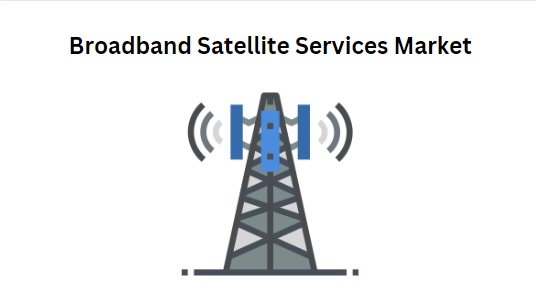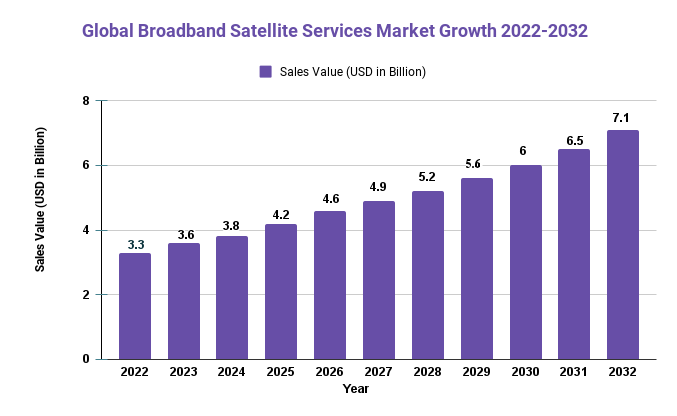Broadband Satellite Services Market Size 7.1 Billion + Factor Analysis by 2032

Page Contents
Market Overview
Broadband satellite services refer to the use of satellite technology to provide internet access to remote and underserved areas. The global broadband satellite services market size is expected to rise from USD 3.3 Billion in 2022 to USD 7.1 Billion by 2032, at an Annual Growth Rate (CAGR) of 8.12% during the forecast period. This growth can be attributed to the increasing demand for high-speed internet connections as well as the rising adoption of satellite-based services across various industries. Broadband satellite services offer several advantages like faster download speeds, wider coverage areas, and cost efficiency which make them popular choices among many customers.
The broadband satellite services market has seen remarkable growth over the past few years and is expected to keep expanding in the foreseeable future. This development is driven by an increasing need for high-speed internet in remote places as well as reliable backup solutions for terrestrial networks. Furthermore, the COVID-19 pandemic has further fuelled this expansion, as more people work from home requiring reliable internet connections. Furthermore, cloud-based applications and services have become more widely adopted, further contributing to its expansion.
North America leads the regional growth for broadband satellite services, followed by Europe and Asia-Pacific. However, Asia-Pacific is expected to experience the highest growth rate due to the increasing adoption of high-speed internet in developing countries. Companies are working hard to expand their geographic reach as well as develop new products and services in response to the growing demand for such connectivity. Overall, global broadband satellite services are expected to keep growing over the coming years, driven by rising demands for high-speed internet connection – especially in remote places and developing nations.
Drivers, trends, and challenges have an impact on market dynamics, which can impact businesses. Request for PDF sample report

Key Takeaways
The global broadband satellite services market is expected to experience rapid growth over the coming years, driven by increasing demand for high-speed internet access in remote and rural locations.
The COVID-19 pandemic has further intensified the need for broadband satellite services, as more people are working and studying from home.
Low Earth Orbit (LEO) satellite constellations are set to revolutionize broadband satellite services with faster speeds, reduced latency, and more cost-effective pricing.
The competition in the broadband satellite services market is heating up with the entry of new players, which should lead to lower prices and better services for customers.
Regional Snapshot
North America is currently the leading market for broadband satellite services due to the high demand for internet access in remote places and the presence of major players in the region.
Europe is anticipated to experience significant growth in the broadband satellite services market due to the increasing adoption of LEO satellite constellations and government initiatives that promote high-speed internet access in rural areas.
The Asia-Pacific region is forecast to experience significant growth, buoyed by increasing demand for broadband services in developing nations like India and China.
Latin America and the Middle East & Africa regions are expected to experience growth in the broadband satellite services market due to the increasing adoption of satellite technology and government initiatives to provide internet access in remote places.
Drivers
- Rising demand for high-speed internet connectivity.
- Increased adoption of satellite-based services across various industries.
- Cost efficiency of broadband satellite services.
- Wider coverage area compared to traditional terrestrial networks.
- Advancements in satellite technologies.
Restraints
- Satellite networks typically have limited bandwidth capacity due to limitations.
- High latency and signal delay occur due to weather-related disruptions that disrupt signal transmission.
- Furthermore, installation and maintenance costs are high.
Browse the summary of the report and Complete Table of Contents: TOC
Opportunities
Bridging the Digital Divide: Broadband satellite services can help bridge the digital divide by providing high-speed internet access to remote and underserved areas where terrestrial infrastructure is either inadequate or nonexistent.
Global Coverage: Broadband satellite services have the potential to offer global coverage, making them ideal for use in maritime, aviation, and military applications.
Increased Demand: The COVID-19 pandemic has driven up demand for high-speed internet connections, leading to an uptick in satellite broadband services.
IoT and M2M Connectivity: Broadband satellite services can offer connectivity for IoT and M2M devices in remote areas, enabling a range of applications such as precision agriculture or asset tracking.
Challenges
Latency: Satellite communications often experience latency, leading to delays that reduce the quality of real-world applications such as video conferencing or online gaming.
Capacity Limitations: Satellite bandwidth is both limited and expensive, making it difficult to meet the growing demand for high-speed internet connection.
Weather Conditions: Adverse weather conditions such as rain, snow, and fog can wreak havoc on satellite communications systems by weakening signal strength and leading to disruptions.
Cost: Launching and maintaining a satellite can be expensive, making it difficult for satellite service providers to offer competitive prices to consumers.
Recent Developments
LEO Satellite Constellations: Companies are exploring launching low Earth orbit (LEO) satellite constellations to offer high-speed broadband services. These constellations will feature lower latency and more bandwidth than traditional geostationary satellites.
5G Integration: Satellite service providers are exploring ways to integrate their offerings with 5G networks for seamless connectivity for consumers.
Ka-Band Satellites: Ka-band satellites offer faster data rates than their Ku-band counterparts, making them ideal for high-speed broadband services.
Partnerships and Collaborations: Satellite service providers are forming partnerships and collaborations with terrestrial network operators and other technology companies in an effort to enhance their service offerings and broaden their market reach.
Key Market Segments
Type
- C Band
- Ku Band
- HTS
- Other
Application
- Public Health Organizations
- Emergency Relief Centers
- Law Enforcement Agencies
Key Market Players
- Gilat Satellite Networks
- Harris CapRock Communications
- Hughes Network Systems
- Inmarsat
- Iridium Communications
- VT iDirect
- Cambium Networks
- EchoStar
- Ligado Networks
- Thrane and Thrane
- Globalstar
- Intelsat General
- Singtel
- Telstra
- Thuraya
- ViaSat
Report Scope
| Report Attribute | Details |
| The market size value in 2022 | USD 3.3 Bn |
| Revenue forecast by 2032 | USD 7.1 Bn |
| Growth Rate | CAGR Of 8.12% |
| Regions Covered | North America, Europe, Asia Pacific, Latin America, and Middle East & Africa, and Rest of the World |
| Historical Years | 2017-2022 |
| Base Year | 2022 |
| Estimated Year | 2023 |
| Short-Term Projection Year | 2028 |
| Long-Term Projected Year | 2032 |
Frequently Asked Questions
Q: How fast is broadband satellite internet?
A: Broadband satellite internet speeds typically range between 25 Mbps and 100 Mbps, depending on the service provider and type of satellite used.
Q: How much does broadband satellite internet cost?
A: Prices for broadband satellite internet plans depend on the service provider, plan type, and location. Monthly charges can range anywhere from $50 to $150 or more per month.
Q: Can Satellite Internet Be Used for Online Gaming?
A: Satellite internet can be utilized for online gaming, however, the latency associated with satellite communications may cause delays and affect the quality of your experience.
Q: How dependable is broadband satellite internet?
A: Broadband satellite internet can be reliable, but adverse weather conditions like rain, snow, or fog may interfere with signal quality and cause interruptions.
Q: Can I Get Broadband Satellite Internet in Remote Areas?
A: Absolutely, broadband satellite internet can be used in areas where terrestrial infrastructure is either inadequate or nonexistent.
The team behind market.us, marketresearch.biz, market.biz and more. Our purpose is to keep our customers ahead of the game with regard to the markets. They may fluctuate up or down, but we will help you to stay ahead of the curve in these market fluctuations. Our consistent growth and ability to deliver in-depth analyses and market insight has engaged genuine market players. They have faith in us to offer the data and information they require to make balanced and decisive marketing decisions.



